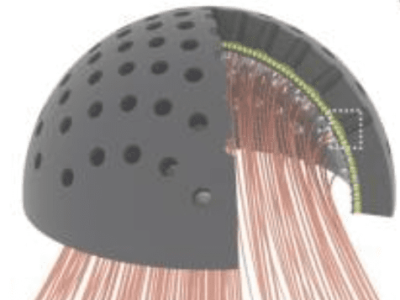
OLED outcoupling layer is wavelength and viewing-angle independent
The paper “Efficient Outcoupling of Organic Light-Emitting Devices Using a Light-Scattering Dielectric Layer” published in ACS Photonics details how the integration of a high index of refraction waveguide layer together with a rough, dielectric diffuse reflector at the bottom of a transparent, top emitting structure eliminates plasmonic, waveguide, and substrate modes without introducing wavelength and viewing-angle dependence.

the light back into the viewing direction (following a Lambertian
profile in red). Light in the emission cone is scattered into the
viewing direction (green cone).
In this study, the authors replaced the conventional bottom metal electrode in top-emitting OLEDs with a transparent layer of indium tin oxide (ITO) deposited on a 240μm thick polytetrafluoroethylene (PTFE, Teflon) diffuse reflector (itself backed by a 20μm thick Al mirror). A planarized high index of refraction (nP = 1.8) polymer slab waveguide covers the rough reflector so as to create a smooth surface on which to fabricate the OLED, while helping maximize the light coupled into the diffuser.
This new approach was demonstrated to increase the external quantum efficiency from 15 ± 2% to 37 ± 4% compared to a similar device with a metal mirror, a 250% improvement.
Light exiting the OLED is either directly emitted from the top surface into the viewing direction or enters the waveguide layer where it propagates until it is scattered by the rough reflector surface into a Lambertian profile. Then light within the emission cone exits into the viewing direction and light incident at angles greater than that for total internal reflection at the polymer−air interface is returned to the diffuse reflector, for another round of scattering.
Running simulations, the authors also claim that this wavelength and viewing angle independent outcoupling structure could further be optimized to yield a 3.4-fold light extraction improvement over the use of a conventional metal mirror.
University of Michigan – www.umich.edu
Related articles:
Cheap and wavelength-independent OLED light extraction
Fabric-based OLEDs promise wearable displays
Flexible OLEDs switch color on demand
Emission-layer-free OLED promises better efficiency
Screen-printed composite boosts OLED light extraction
 If you enjoyed this article, you will like the following ones: don't miss them by subscribing to :
eeNews on Google News
If you enjoyed this article, you will like the following ones: don't miss them by subscribing to :
eeNews on Google News



